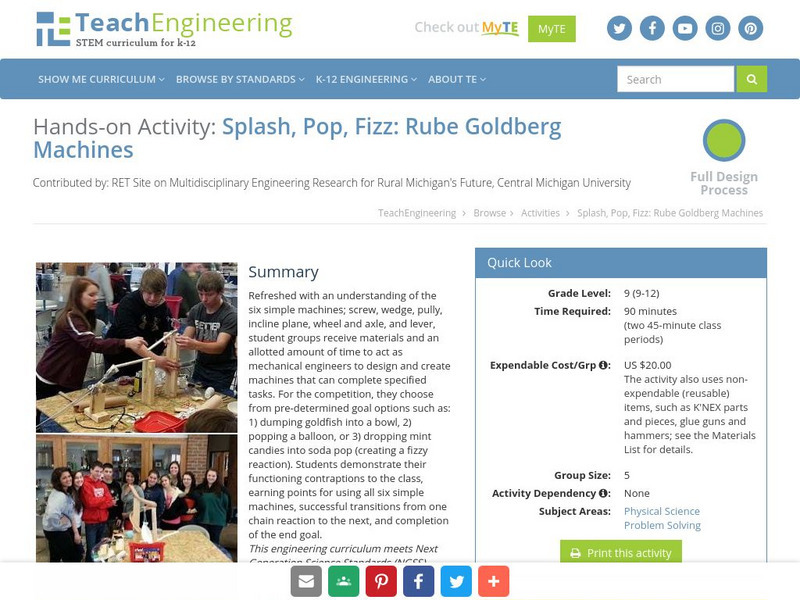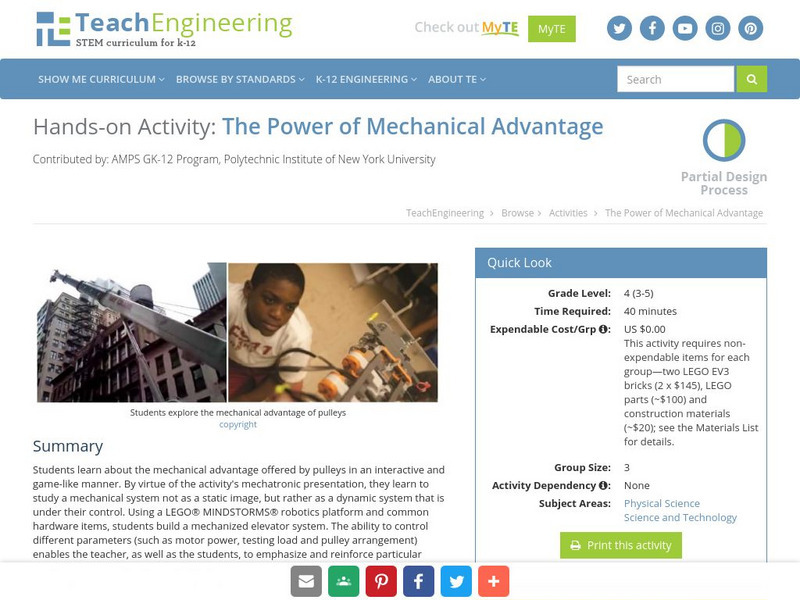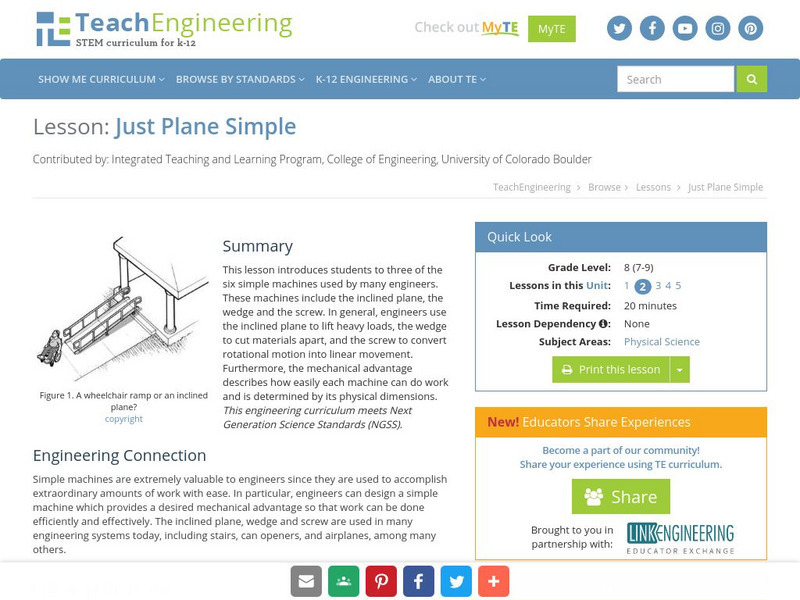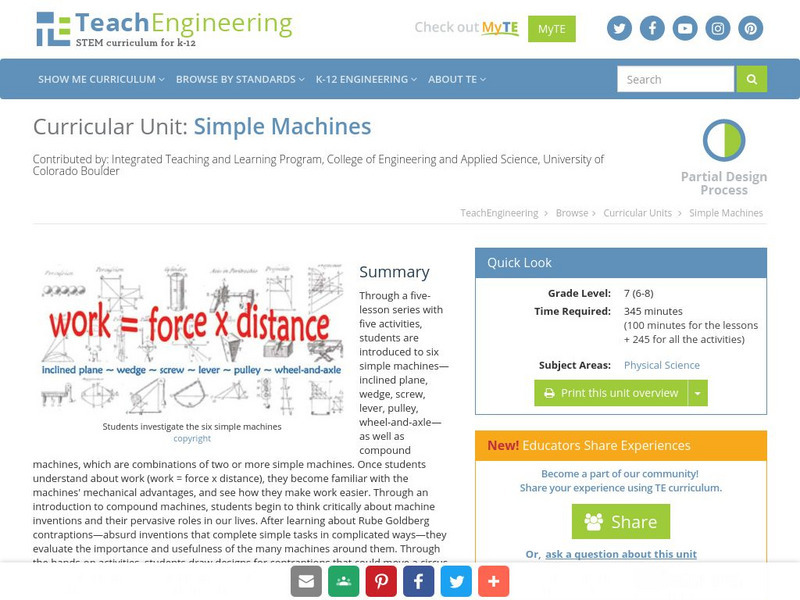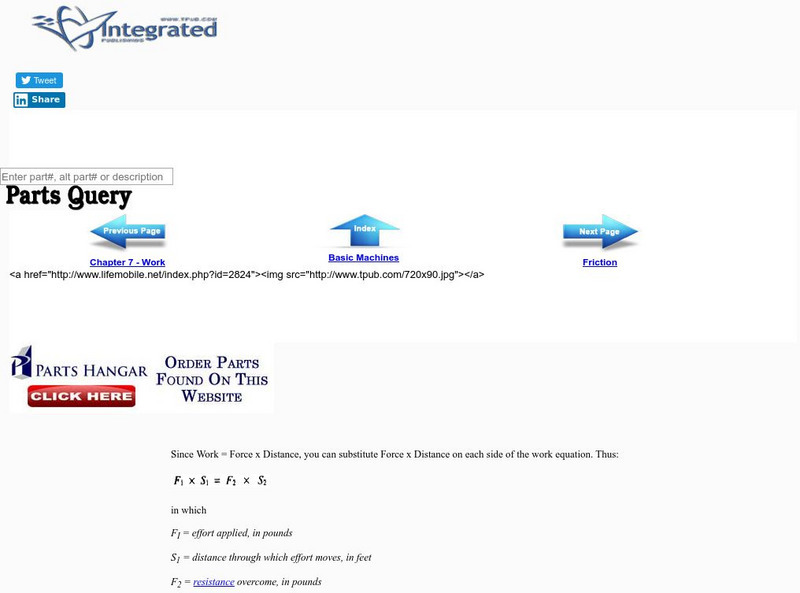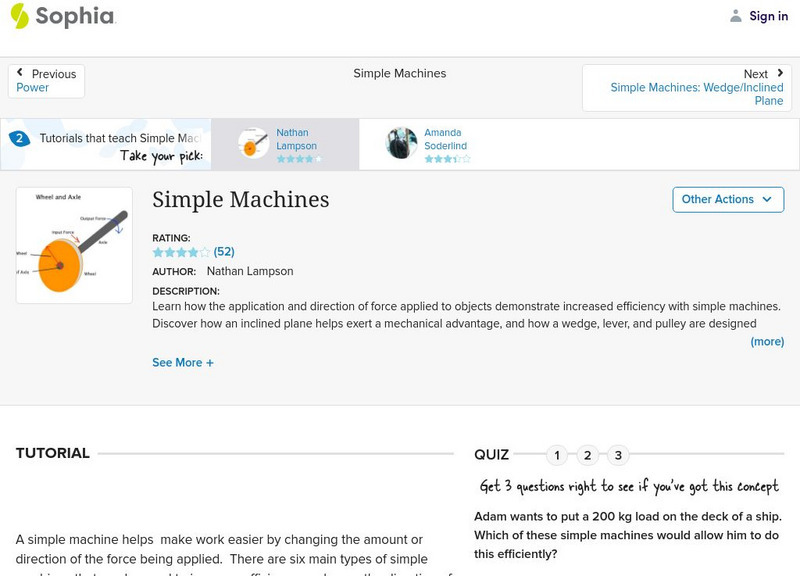OpenStax
Open Stax: Simple Machines
From a chapter on Statics and Torque in a Physics textbook. This section of the chapter discusses the different types of simple machines and how to calculate their mechanical advantage. Includes questions, problems and exercises.
TeachEngineering
Teach Engineering: Splash, Pop, Fizz: Rube Goldberg Machines
Refreshed with an understanding of the six simple machines; screw, wedge, pully, incline plane, wheel and axle, and lever, student groups receive materials and an allotted amount of time to act as mechanical engineers to design and...
TeachEngineering
Teach Engineering: Tools and Equipment, Part I
Through a series of activities, students discover that the concept of mechanical advantage describes reality fairly well. They act as engineers creating a design for a ramp at a construction site by measuring four different inclined...
TeachEngineering
Teach Engineering: Machines and Tools, Part Ii
In this activity, students gain first-hand experience with the mechanical advantage of pulleys. Students are given the challenge of helping save a whale by moving it from an aquarium back to its natural habitat into the ocean. They set...
TeachEngineering
Teach Engineering: The Power of Mechanical Advantage
Students learn about the mechanical advantage offered by pulleys in an interactive and game-like manner. By virtue of the activity's mechatronic presentation, they learn to study a mechanical system not as a static image, but rather as a...
TeachEngineering
Teach Engineering: Just Plane Simple
This instructional activity introduces students to three of the six simple machines used by many engineers. These machines include the inclined plane, the wedge and the screw. In general, engineers use the inclined plane to lift heavy...
TeachEngineering
Teach Engineering: The Claw
Students learn about gear ratios and power by operating toy mechanical cranes of differing gear ratios. They attempt to pick up objects with various masses to witness how much power must be applied to the system to oppose the force of...
TeachEngineering
Teach Engineering: Simple Machines
Through a five-lesson series with five hands-on activities, students are introduced to six simple machines - inclined plane, wedge, screw, lever, pulley, wheel-and-axle - as well as compound machines, which are combinations of two or...
Other
Mechanical Systems
A collection of resources on how humans use machines and tools to meet their needs. Covers simple and complex machines, subsystems that transfer forces, mechanical advantage, speed ratio, the effect of friction, efficiency, the science...
Science Education Resource Center at Carleton College
Serc: Comparing Mechanical Advantage and Efficiency of Pulleys
Students determine the mechanical advantage of three pulley set-ups. Then they measure the work input and output to calculate the efficiency. Finally, students determine the relationship between the mechanical advantage and the...
Ohio State University
Ohio State Univ.: Simple Machines & Mechanical Advantage [Pdf]
This site details how simple machines create a mechanical advantage for humans. Levers, theoretical mechanical advantage, actual mechanical advantage, and pulley systems are discussed.
TeachEngineering
Teach Engineering: Rube Goldberg and the Meaning of Machines
Simple and compound machines are designed to make work easier. When we encounter a machine that does not fit this understanding, the so-called machine seems absurd. In this lesson, the cartoons of Rube Goldberg are introduced and engage...
TeachEngineering
Teach Engineering: Powerful Pulleys
Young scholars continue to explore the story of building a pyramid, learning about the simple machine called a pulley. They learn how a pulley can be used to change the direction of applied forces and move/lift extremely heavy objects,...
CK-12 Foundation
Ck 12: Physical Science: Mechanical Advantage
[Free Registration/Login may be required to access all resource tools.] Actual and ideal mechanical advantage, how to calculate them and the mechanical advantage of different types of machines.
CK-12 Foundation
Ck 12: Physical Science: Screw
[Free Registration/Login may be required to access all resource tools.] What a screw is, how it works and its mechanical advantage.
CK-12 Foundation
Ck 12: Physical Science: Wedge
[Free Registration/Login may be required to access all resource tools.] What a wedge is and its mechanical advantage, how it changes force to make work easier.
Integrated Publishing
Integrated Publishing: The Inclined Plane and the Wedge
Outlines the wedge and inclined plane, including their uses in everyday life and their mechanical advantages.
Integrated Publishing
Integrated Publishing: Pulley Mechanical Advantage
Good illustrations and explanations for finding the mechanical advantage of pulley systems.
Integrated Publishing
Integrated Publishing: How Mechanical Advantage Is Used
Describes how pulley systems are used in the real world, including the role of the mechanical advantage in selecting the proper pulley system.
Integrated Publishing
Integrated Publishing: Force and Mechanical Advantage
Explains the relationship between force and mechanical advantage with diagrams, examples and calculations.
Sophia Learning
Sophia: Simple Machines: Lesson 2
This lesson will introduce the six types of simple machines and show how machines can increase efficiency by reducing work input needed. It is 2 of 2 in the series titled "Simple Machines."
Sophia Learning
Sophia: Simple Machines: Lesson 1
This lesson will introduce the six types of simple machines and show how machines can increase efficiency by reducing work input needed. It is 1 of 2 in the series titled "Simple Machines."
Integrated Publishing
Integrated Publishing: Mechanical Advantage
Good descriptions and diagrams to help explain the mechanical advantage of machines. Includes sample calculations of this quantity.



